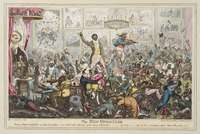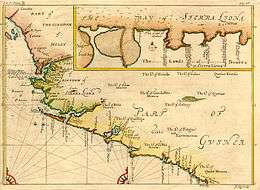African Institution
The African Institution was founded in 1807 after British abolitionists succeeded in ending the slave trade based in the United Kingdom. The Institution was formed to succeed where the former Sierra Leone Company had failed—to create a viable, civilized refuge for freed slaves in Sierra Leone, Africa.
History

Where the Sierra Leone Company sought first to convert the native population through evangelism, the African Institution aimed to improve the standard of living in Freetown first.[1] Rules and regulations were proposed at its first meeting on 14 April 1807. One aspect of its purpose was to repair the wrongs which the native Africans had suffered in their intercourse with Europeans.[2]
The leaders of the African Institution were James Stephen and William Wilberforce.[3] The Duke of Gloucester, nephew of King George III, acted as the Institution's first president, and was joined by clergymen and aristocrats.[4] Leading Quaker families also became supporters[5] as well as Unitarians like Peter Finch Martineau.[6]
Paul Cuffe
The Institution showed close interest in working with Paul Cuffe, an African-American entrepreneur. In 1810–1 they approached the British government, requesting a land grant in Sierra Leone for him.[7]
The African merchants of Freetown, Sierra Leone, were however prevented from getting ahead, by the tight monopoly which the British merchant company Macaulay and Babington held over the Sierra Leone trade.[8] On 7 April 1811 Cuffe met with the foremost black merchants of the colony, including the successful John Kizell. They penned a petition to the African Institution, stating that the colony's greatest needs were for settlers to work in agriculture, commerce and whaling; and that these three areas would facilitate growth for the colony best. Upon receiving this petition, the members of the Institution agreed with their findings.[9] Cuffe and these merchants together founded the Friendly Society of Sierra Leone, a local mutual-aid merchant group dedicated to furthering prosperity and industry among the free peoples in the colony and loosening the stranglehold that English merchants held on trade.[10]

Indian Ocean
The Institution took action in negotiating with Said bin Sultan, Sultan of Muscat and Oman to reduce the prevalence of slavery in his possessions, which included Zanzibar. This was in 1820, some five years after the East India Company had become involved with the Sultan, through the Governor of Bombay, Sir Evan Nepean. In 1821, Ralph Darling who was Governor of Mauritius also took steps against the slave trade.[11][12]
Reports
The Committee of the African Institution produced a series of annual Reports, from 1807 to 1824.[13]
First Report (1807)
Report of the Committee of the African Institution, presented 15 July 1807:
- The committee expressed its view that the people of Africa were sunk in ignorance and barbarism and took for itself the task of introducing the blessings of civilisation to what they viewed as constituting a quarter of the habitable globe.
Second Report (1808)
Second Report of the Committee of the African Institution, presented 25 March 1808:
- This report starts with the announcement of a series of prizes valued at 50 Guineas for the being the first person to import from West Africa to Great Britain the following quantities of goods:
- A further 50 Guinea prize was offered to the person who put the most land in West Africa under Coffee cultivation, as long as it was at least ten acres.
Third report (1809)
Third Report of the Committee of the African Institution, presented 25 March 1809:
- The directors reported that three African youths had received training in a new educational procedure developed at the Duke of York's Royal Military School from techniques developed in India. Thanks to the intervention of the Duke of Gloucester, the youths participated as teacher at the Asylum before being sent to Sierra Leone, where they were employed as teachers by the Secretary of State for War and the Colonies, the Earl of Liverpool. One of the skills it was hoped they would introduce to Sierra Leone was cotton cultivation.
Fourth Report (1810)
Fourth Report of the Committee of the African Institution, presented 28 March 1810:
Fifth Report (1811)
Fifth Report of the Directors of the African Institution, presented 27 March 1811:
- The directors with dismay reported the continuing activity of British and American ships continuing to pursue the slave trade using Portuguese and Spanish flags of convenience. They identified British capital and credit playing a large part in this considerable trade. Through Henry Brougham MP they initiated a discussion in the Houses of Parliament followed by the introduction of a bill to make it easier to prosecute British nationals using flags of convenience to avoid prosecution at the Vice-Admiralty courts set up in Sierra Leone.
Sixth Report (1812)
Sixth Report of the Committee of the African Institution, presented at the Freemasons' Tavern, London 25 March 1812:
- The directors reported with concern that they had previously underestimated the growth in the slave trade providing an estimate of 70-80,000 enslaved Africans being transported across the Atlantic in 1810. They highlighted the role of the port of Bissau in this development.
Seventh Report (1813)
Seventh Report of the Committee of the African Institution, presented at the Freemasons' Tavern, London 24 March 1813:
- The directors were pleased to report that there had been a decline in the slave trade and expressed their gratitude to the efforts of two naval officers: Commodore Frederick Paul Irby and Captain Edward Scobell
Eighth Report (1814)
Report of the Directors of the African Institution, presented 23 March 1814:
- The directors reported on their concern with outstanding legal cases concerning the seizure of Portuguese ships engaged in the slave trade. They again commended Captain Irby of HMS Amelia and Captain Scobell of HMS Thais for their active involvement with suppressing the slave trade as part of the West Africa Squadron. They noted the action taken against a slave factory at Cape Mesurado
Ninth Report (1815)
Ninth Report of the Directors of the African Institution, presented London 12 April 1815:
- The Directors expressed their delight with the sentiment expressed by the Congress of Vienna that the slave trade constituted "the desolation of Africa, the degradation of Europe and the afflicting scourge of humanity." However when this was not implemented immediately through the Treaty of Paris (1814), they expressed their disappointment. They pointed out that as there was no French Capital invested in the Slave trade, the delay of introducing a ban on the slave trade for five years amounted to an introduction of the slave trade to France.
Special Report, 1815
A Special Report was produced in 1815 to rebut an attack on the Institution by Robert Thorpe.[14] The seventh annual report had noted a deterioration of conditions in Sierra Leone, yet had made upbeat comments about all involved. Concerned parties—William Allen and John Clarkson—expressed disquiet, while Thorpe made unmeasured criticisms, pamphleteering and targeting Zachary Macaulay. Henry Brougham headed an internal enquiry at the beginning of 1814, with Wilberforce, Macaulay and Thomas Clarkson. The outcome was that Thomas Perronet Thompson, governor in Sierra Leone and at odds with leading evangelicals, who had already been removed in 1810, was roundly criticised.[15][16]
Twelfth Report, 1818
Twelfth Report of the Directors of the African Institution presented on 9 April 1818:
- The Directors restated their fears that the activities of the West Africa Squadron in suppressing the slave trade might be severally constrained following the outbreak of peace. This, they confirmed had happened, recounting the judgement of William Scott concerning the French ship Le Lois. HMS Queen Charlotte had seized Le Lois and the Vice Admiralty Court at Sierra Leone had condemned the ship and her cargo. However, when the owners appealed to the High Court of Admiralty, Scott overturned the previous judgement saying that the way Le Lois had been stopped and boarded was illegal as "No nation can exercise a right of visitation and search on the common and unappropriated parts of the sea, save only on the belligerent claim." He accepted that this would constitute a serious impediment to the suppression of the slave trade, but argued that this should be remedied through international treaties rather than naval officers exceeding what they were permitted to do.:3–4
Sixteenth Report (1822)
Sixteenth Report of the Directors of the African Institution, presented 10 May 1822:
- The report was delivered to a meeting of over 1,500 people. After a motion of thanks to the Directors, this meeting passed a motion that they would emplore the British government to ensure that the slave trade should be declared piracy by the "concurrent sentence of all nations".:xv
Anti-Slavery Society (1823)
The Society for the Mitigation and Gradual Abolition of Slavery Throughout the British Dominions, usually known as the "Anti-Slavery Society", was set up in 1823. Its leadership overlapped substantially with that of the African Institution. It involved James Cropper and Thomas Babington Macaulay, and was somewhat more open in approach.[17]
Dormancy and demise
The Twentieth Report (1826) of the Institution concentrated on being informative, rather than summarising activity or raising funds. Wilberforce had retired. By about 1828 such activism as came from the underlying group was in practice being run by the Anti-Slavery Society.[18]
References
- Thomas, p 140, note 15
- Rules and regulations of the African Institution. London: African Institution. 1807. Retrieved 20 July 2016.
Tuke Sierra Leone.
- James Stuart Olson; Robert Shadle (1996). Historical Dictionary of the British Empire. Greenwood Publishing Group. p. 15. ISBN 978-0-313-29366-5.
- Thomas, Lamont D. Paul Cuffe: Black Entrepreneur and Pan-Africanist (Urbana and Chicago: University of Illinois Press, 1988) pp. 32–33
- Clare Midgley (2 August 2004). Women Against Slavery: The British Campaigns, 1780-1870. Routledge. p. 32. ISBN 978-1-134-79880-3.
- Ronalds, B.F. (February 2018). "Peter Finch Martineau and his Son". The Martineau Society Newsletter. 41: 10–19.
- Junius P. Rodriguez (26 March 2015). Encyclopedia of Emancipation and Abolition in the Transatlantic World. Routledge. p. 156. ISBN 978-1-317-47180-6.
- Thomas, p. 44–51
- Thomas, p. 80
- Thomas, pp. 53–54 and Harris, Sheldon. Paul Cuffe: Black America and the African Return (New York: Simon and Schuster, 1972) p. 55
- Cynthia Brantley (1981). The Giriama and Colonial Resistance in Kenya, 1800-1920. University of California Press. p. 27. ISBN 978-0-520-04216-2.
- African Institution (1821). Report of the Directors of the African Institution Read at the Annual General Meeting: On the . p. 63.
- Philip D. Curtin (1973). The Image of Africa: British Ideas and Action, 1780-1850. Univ of Wisconsin Press. pp. 138 note 33. ISBN 978-0-299-83025-0.
- Robert Finch (1816). Taylor Institution to the University. p. 341.
- Ellen Gibson Wilson (25 November 1980). John Clarkson and the African Adventure. Palgrave Macmillan UK. pp. 180–1. ISBN 978-1-349-04675-1.
- Turner, Michael J. "Thompson, Thomas Perronet". Oxford Dictionary of National Biography (online ed.). Oxford University Press. doi:10.1093/ref:odnb/27280. (Subscription or UK public library membership required.)
- Wayne Ackerson (1 January 2005). The African Institution (1807–1827) and the Antislavery Movement in Great Britain. E. Mellen Press. p. 194. ISBN 978-0-7734-6129-1.
- Wayne Ackerson (1 January 2005). The African Institution (1807–1827) and the Antislavery Movement in Great Britain. E. Mellen Press. pp. 215 and 218. ISBN 978-0-7734-6129-1.
Further reading
- Sherwood, Henry Noble. "Pathfinder in Negro Colonization" The Journal of Negro History, Vol. 8, No. 2 (Apr., 1923), 194-202. Article Stable URL: https://www.jstor.org/stable/2713609
- Wiggins, Rosalind C. "Paul and Stephen, Unlikely Friends" Quaker History, Vol. 90, No. 1, African-Americans and Quakers (Spring 2001), 8-27. Article Stable URL: https://www.jstor.org/stable/41947772